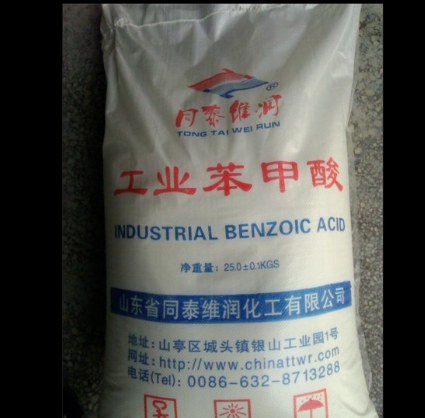On April 8, the reporter learned that with the help of a new type of catalyst, Indian researchers successfully converted toluene, a petroleum waste, into benzoic acid, which can be used as a food preservative and anti-fungal and bacterial infection medicine. Related papers were recently published online in the Dutch Journal of Applied Catalysis B: Environment.

In general, complex organic reactions use organic solvents, which make the reaction more expensive and produce toxic waste. Unlike the previous approach, the Indian Institute of Technology researchers use water as a solvent and a green oxidant called tert-butyl hydroperoxide (TBHP) to convert toluene. Four products are usually produced when toluene is oxidized, but only benzoic acid is produced after using a new type of panaphthol to stabilize platinum nanocatalyst.
Benzoic acid is a scaly or needle-like crystal with the smell of benzene or formaldehyde, with the chemical formula C6H5COOH. The melting point is 122.13°C, the boiling point is 249°C, and the relative density is 1.2659 (15/4°C). It sublimates rapidly at 100°C, and its vapor is very irritating, and can easily cause coughing after inhalation. Slightly soluble in water, soluble in organic solvents such as ethanol and ether. Benzoic acid is a weak acid, stronger than fatty acids. They have similar chemical properties and can form salts, esters, acid halides, amides, acid anhydrides, etc., and are not easily oxidized. Electrophilic substitution reactions can occur on the benzene ring of benzoic acid, and meta-substitution products are mainly obtained.

Industrially, benzoic acid reacts with alkali to form benzoate, for example, benzoic acid reacts with sodium hydroxide to form sodium benzoate. Sodium benzoate is the most common preservative and can be used in the food industry and other industries. Benzoic acid and other bases, such as potassium hydroxide, produce potassium benzoate. Alkali metal salts of benzoic acid such as sodium benzoate and potassium benzoate are water-soluble. The salts formed by the reaction of benzoic acid with alkaline earth metals or metal basic compounds of transition elements, such as calcium benzoate, zinc benzoate, copper benzoate, etc., are oil-soluble.
Benzoic acid reacts with alcohol to form esters, such as methyl benzoate and ethyl benzoate with methanol and ethanol. Benzoic acid reacts with phenethyl alcohol to produce phenethyl benzoate. The esters of benzoic acid can be transesterified with alcohol to generate corresponding esters. Esters of benzoic acid tend to have aroma and can be used for fragrance.
It is understood that the petroleum industry produces a large amount of solid waste from upstream (exploration and development of oil and gas fields), midstream (gathering, transportation, storage and transportation of oil and natural gas) to downstream (oil refining and petrochemical industry). These solid wastes mainly come from production processes. Itself and sewage treatment facilities. Consolidation and drilling cuttings of waste mud from drilling wellsites, and cement left on wellsites from cementing operations are all solid wastes from the upstream of the petroleum industry. In the downstream of the petroleum industry, almost all production devices in the petroleum refining process produce solid waste. In 2001, 180 oil and gas mining enterprises in my country produced 1.8 million tons of solid waste, of which 1.04 million tons were used comprehensively (57.1%); 945 oil processing and coking enterprises produced 11.06 million tons of solid waste, of which 6.74 million tons (60.9%) were used. There are many types of solid waste produced in the petroleum industry, mainly including waste acid, waste lye, waste white clay residue, waste shale residue, oil sludge at the bottom of oil tanks, various waste catalysts, and activated sludge from sewage treatment plants. Among these solid wastes, spent catalysts and fly ash from thermal power plants owned by petrochemical companies account for a large proportion. There are a large number of metal pollutants on the spent catalyst; while the domestic utilization rate of fly ash is currently low, only about 30%, and a large amount of it is stored in ash yards, and most of the ash yards are stacked on cultivated land. According to statistics, my country’s coal ash has accumulated more than 1.3 billion tons, covering an area of 333.3 million square meters. In addition, a large amount of money has to be spent on the dam maintenance of the ash yard. In windy weather, the coal ash in the ash yard is lifted up and seriously pollutes the air. Ash infiltrates into the ground and can also cause groundwater pollution. Therefore, if these solid wastes are not comprehensively treated and utilized, they will pollute the environment and occupy land.

According to the researchers, platinum nanoparticles are generally not stable in nature because they tend to aggregate into large particles and their catalytic activity will decrease. The researchers used panaphthol as a stabilizer to bind platinum nanoparticles to prevent platinum nanoparticles from agglomerating and make them easy to handle. Experiments have proved that the particle size of the new catalyst has not changed after repeated use for 5 times.
The researchers also found that using TBHP alone as an oxidant to convert toluene requires a large amount of toluene. Four parts of TBHP can convert one part of toluene, which is not economically cost-effective. Therefore, they also use molecular oxygen as a co-oxidant, so that only two parts of TBHP are needed to produce one part of toluene, which not only helps reduce costs, but also increases the yield of benzoic acid.
Original link: https://www.xianjichina.com/special/detail_393735.html
Source: Xianji.com
The copyright belongs to the author. For commercial reprints, please contact the author for authorization. For non-commercial reprints, please indicate the source.